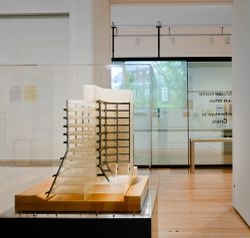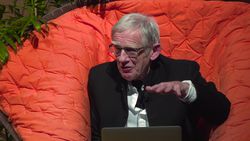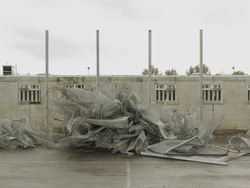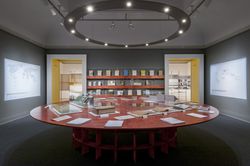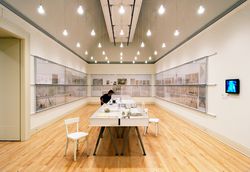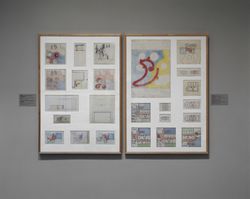Architect James Frazer Stirling’s work has resisted characterization because of its radical shifts in influence, named by others as prewar modernism to Neoclassicism, Rationalism and Brutalism to Postmodernism. But the continuity of his thinking emerges through the quantity and variety of material in the James Stirling/Michael Wilford Archive, a tool for understanding an(...)
Main galleries
16 May 2012 to 14 October 2012
Notes from the Archive: James Frazer Stirling
Actions:
Description:
Architect James Frazer Stirling’s work has resisted characterization because of its radical shifts in influence, named by others as prewar modernism to Neoclassicism, Rationalism and Brutalism to Postmodernism. But the continuity of his thinking emerges through the quantity and variety of material in the James Stirling/Michael Wilford Archive, a tool for understanding an(...)
Main galleries
textual records
ARCH174253
Description:
Contient des photographies de la maquette (10 décembre 1991), une estimation ordre de grandeur. Travaux d'architecture (9 décembre 1991), une ébauche de plan d'escalier circulaire 8.24” x 10”, 2 photocopies de plan 8.5” x 11”, un devis préliminaire du casse-croûte (2 pages 8.5” x 14”), photocopie de la coupe longitudinale (8.5” x 14”), correspondance entre l'atelier de Luc Laporte et des intervenants à Tecsult, Lumitech, Gidev, Cardinal & Hardy, S.V.P.M. et autres, factures diverses et détails de mat.
circa 1991
Correspondance avec ingénieurs, architectes et client, documents financiers, devis, plans, détails et coupes du pavillon, Pavillon du Bassin Bonsecours, Montréal, Québec
Actions:
ARCH174253
Description:
Contient des photographies de la maquette (10 décembre 1991), une estimation ordre de grandeur. Travaux d'architecture (9 décembre 1991), une ébauche de plan d'escalier circulaire 8.24” x 10”, 2 photocopies de plan 8.5” x 11”, un devis préliminaire du casse-croûte (2 pages 8.5” x 14”), photocopie de la coupe longitudinale (8.5” x 14”), correspondance entre l'atelier de Luc Laporte et des intervenants à Tecsult, Lumitech, Gidev, Cardinal & Hardy, S.V.P.M. et autres, factures diverses et détails de mat.
textual records
circa 1991
Individuals act as their own historians, suppressing some stories and emphasizing others. But at the scale of nations and cultures, and especially in this age of ubiquitous digital memory, it has become more difficult to forget. Building on questions about history and its uses, raised by exhibitions like Educating Architects: Four Courses by Kenneth Frampton and Besides,(...)
7 December 2017
Come and Forget the Internet, with Evgeny Morozov
Actions:
Description:
Individuals act as their own historians, suppressing some stories and emphasizing others. But at the scale of nations and cultures, and especially in this age of ubiquitous digital memory, it has become more difficult to forget. Building on questions about history and its uses, raised by exhibitions like Educating Architects: Four Courses by Kenneth Frampton and Besides,(...)
Individuals act as their own historians, suppressing some stories and emphasizing others. But at the scale of nations and cultures, and especially in this age of ubiquitous digital memory, it has become more difficult to forget. Building on questions about history and its uses, raised by exhibitions like Educating Architects: Four Courses by Kenneth Frampton and Besides,(...)
Craig Hodgetts
29 March 2018
Come and Forget the Grid, with Craig Hodgetts
Actions:
Description:
Individuals act as their own historians, suppressing some stories and emphasizing others. But at the scale of nations and cultures, and especially in this age of ubiquitous digital memory, it has become more difficult to forget. Building on questions about history and its uses, raised by exhibitions like Educating Architects: Four Courses by Kenneth Frampton and Besides,(...)
Craig Hodgetts
The H-Block buildings of Maze Prison were a potent symbol of the often violent political struggles in Northern Ireland known today as the Troubles. The prison, opened in 1971 by the British government, was designed to keep apart warring loyalist and republican paramilitaries, the latter demanding to be treated as prisoners of war rather than criminals. As part of this(...)
Octagonal gallery
5 September 2013 to 12 January 2014
H-BLOCK: Prison Housing – Donovan Wylie
Actions:
Description:
The H-Block buildings of Maze Prison were a potent symbol of the often violent political struggles in Northern Ireland known today as the Troubles. The prison, opened in 1971 by the British government, was designed to keep apart warring loyalist and republican paramilitaries, the latter demanding to be treated as prisoners of war rather than criminals. As part of this(...)
Octagonal gallery
Sub-series
AP156.S5.SS1
Description:
La sous-série documente les photographies de Chandigarh et des alentours prises par Pierre Jeanneret et d'autres photographes qui ont été sélectionnées pour une exposition au Musée des Beaux-Arts de Besançon, en France, en 1971. La sous-série inclut des photographies de la vie quotidienne à Chandigarh, des résidences privées et gouvernementales, des écoles, de l'Université du Panjab, du Capitol, de divers bâtiments et installations et de maquettes. Le matériel dans cette sous-série a été produit entre 1951 et 1966. La sous-série contient des photographies montées sur carton. Sub-series documents the photographs of Chandigarh and the surrounding area taken by Pierre Jeanneret and other photographers that were selected for an exhibition at the Musée des Beaux-Arts at Besançon, in France, in 1971. The sub-series includes photographs of everyday life in Chandigarh, the private and governement residences, the schools, the Panjab University, the Capitol, various buildings and installations, and models. The material in this sub-series was produced between 1951 and 1966. The sub-series contains photographs mounted on board.
1951-1966
Photographies pour une exposition au musée des Beaux-arts à Besançon, 1971 = Photographs for an exhibition at the Musée des Beaux-Arts at Besançon, 1971
Actions:
AP156.S5.SS1
Description:
La sous-série documente les photographies de Chandigarh et des alentours prises par Pierre Jeanneret et d'autres photographes qui ont été sélectionnées pour une exposition au Musée des Beaux-Arts de Besançon, en France, en 1971. La sous-série inclut des photographies de la vie quotidienne à Chandigarh, des résidences privées et gouvernementales, des écoles, de l'Université du Panjab, du Capitol, de divers bâtiments et installations et de maquettes. Le matériel dans cette sous-série a été produit entre 1951 et 1966. La sous-série contient des photographies montées sur carton. Sub-series documents the photographs of Chandigarh and the surrounding area taken by Pierre Jeanneret and other photographers that were selected for an exhibition at the Musée des Beaux-Arts at Besançon, in France, in 1971. The sub-series includes photographs of everyday life in Chandigarh, the private and governement residences, the schools, the Panjab University, the Capitol, various buildings and installations, and models. The material in this sub-series was produced between 1951 and 1966. The sub-series contains photographs mounted on board.
Sous-série 1
1951-1966
The beginning of the 1950s was a moment of global upheaval. From India to Morocco, from Guatemala to Indochina, the process of decolonization gained momentum and the Cold War began. Architects working or acting as experts in the non-Western areas of the globe could no longer plan as if sites were terrains vague and people were mute subjects. The end of colonial(...)
Main galleries Keyword(s):
Casablanca, Chandigarh, Le Corbusier, Jeanneret, Morocco, Punjab, India, Morocco, modernism, Africa, Takashi Homma, Yto Barrada
26 November 2013 to 20 April 2014
How architects, experts, politicians, international agencies and citizens negotiate modern planning: Casablanca Chandigarh
Actions:
Description:
The beginning of the 1950s was a moment of global upheaval. From India to Morocco, from Guatemala to Indochina, the process of decolonization gained momentum and the Cold War began. Architects working or acting as experts in the non-Western areas of the globe could no longer plan as if sites were terrains vague and people were mute subjects. The end of colonial(...)
Main galleries Keyword(s):
Casablanca, Chandigarh, Le Corbusier, Jeanneret, Morocco, Punjab, India, Morocco, modernism, Africa, Takashi Homma, Yto Barrada
Starting from diverse premises and points of view, Cedric Price, Aldo Rossi, James Stirling, and Gordon Matta-Clark each engaged in a radical rethinking of the status, history, and purpose of architecture. out of the box: price rossi stirling + matta-clark brings the ideas of these four pivotal figures of the 1970s into dialogue through a group of archives that recently(...)
Main galleries
23 October 2003 to 6 September 2004
out of the box: price rossi stirling + matta-clark
Actions:
Description:
Starting from diverse premises and points of view, Cedric Price, Aldo Rossi, James Stirling, and Gordon Matta-Clark each engaged in a radical rethinking of the status, history, and purpose of architecture. out of the box: price rossi stirling + matta-clark brings the ideas of these four pivotal figures of the 1970s into dialogue through a group of archives that recently(...)
Main galleries
Paul Nelson (1895–1979), American architect, film set designer, painter, critic, and educator, taught and practised architecture in the United States and France for over fifty years. Nelson was a central figure in the development of functionalism in the 1930s and 1940s, which rejected the Beaux-Arts language in favour of technological and functional expression. The Filter(...)
Main galleries
27 March 1991 to 26 May 1991
The Filter of Reason: The Work of Paul Nelson
Actions:
Description:
Paul Nelson (1895–1979), American architect, film set designer, painter, critic, and educator, taught and practised architecture in the United States and France for over fifty years. Nelson was a central figure in the development of functionalism in the 1930s and 1940s, which rejected the Beaux-Arts language in favour of technological and functional expression. The Filter(...)
Main galleries
According to a Chinese legend well-known in Japan, a giant katsura tree was planted on the moon, inspiring the proverb, “We can see the katsura on the moon with our eyes, but we cannot touch it with our hands.” The saying celebrates the quest for an absolute and is a fitting epigraph for Departure for Katsura, which pursues issues of self-identity and personal(...)
Octagonal gallery, hall cases, and Sottsass Room
9 December 1998 to 28 March 1999
Irene F. Whittome: Departure for Katsura
Actions:
Description:
According to a Chinese legend well-known in Japan, a giant katsura tree was planted on the moon, inspiring the proverb, “We can see the katsura on the moon with our eyes, but we cannot touch it with our hands.” The saying celebrates the quest for an absolute and is a fitting epigraph for Departure for Katsura, which pursues issues of self-identity and personal(...)
Octagonal gallery, hall cases, and Sottsass Room
